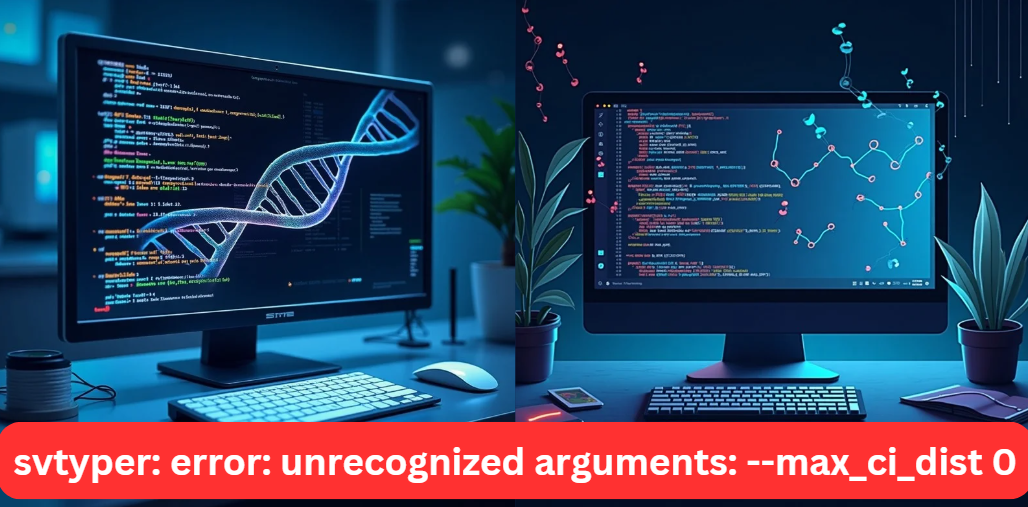Resolving svtyper: error: unrecognized arguments: –max_ci_dist 0
Structural variant calling is a crucial aspect of modern bioinformatics, enabling researchers to understand genomic variations accurately. Svtyper is an essential tool for genotyping structural variants, and its integration in workflows, such as those involving smoove, is widespread.
However, users sometimes encounter the error svtyper: error: unrecognized arguments: –max_ci_dist 0. This guide explains why this error occurs, explores its underlying causes, and provides a comprehensive roadmap to resolve it, ensuring your variant calling pipelines remain efficient and up-to-date.
Understanding svtyper
Svtyper is a Bayesian genotyper designed specifically for structural variants. It plays a key role in interpreting breakpoint evidence from sequencing data. With the increasing complexity of genomic analyses, svtyper has evolved, incorporating new parameters to improve accuracy. The --max_ci_dist flag, for example, is used to define the maximum confidence interval distance considered during genotype computations. In earlier versions of svtyper, this flag was not implemented, leading to the error when users invoke it. This section clarifies the purpose of svtyper and the significance of its recent updates.
The Evolution of svtyper
Over time, svtyper has incorporated several new parameters aimed at fine-tuning the analysis of structural variants. A brief comparison is provided in the table below to highlight differences between older and newer versions:
| Feature | Older Versions (e.g., v0.1.4) | Newer Versions (e.g., v0.7.0) |
|---|---|---|
| –max_ci_dist Flag | Not supported | Supported |
| Confidence Interval Use | Fixed defaults | User-adjustable via flag |
| Command-line Flexibility | Limited | Enhanced options |
| Integration with smoove | May cause errors | Smoother workflow |
This evolution underscores the need for updating your software to benefit from improved functionality and avoid errors like svtyper: error: unrecognized arguments: –max_ci_dist 0.
Decoding the Error Message
The error message svtyper: error: unrecognized arguments: –max_ci_dist 0 indicates that the svtyper binary does not recognize the --max_ci_dist flag being passed to it. In simpler terms, your version of svtyper is likely outdated or misconfigured. The flag itself is intended to set a threshold for the maximum confidence interval distance used during breakpoint genotyping. When this flag is not recognized, the tool fails to process your command correctly, leading to a halt in the analysis.
What Does the Flag Do?
The --max_ci_dist flag allows users to define a custom cutoff for the size of the confidence interval before the tool defaults to using the 95% confidence interval. This is particularly important when dealing with varying levels of read quality and sample coverage in structural variant analyses.
Root Causes and Common Scenarios
Several factors can lead to this error, and understanding them is the first step in troubleshooting:
- Outdated Version of svtyper: Many users report that the error occurs because their installation of svtyper is an older version that does not support the
--max_ci_distparameter. - Incorrect Command-Line Syntax: Sometimes, typographical errors or incorrect flag usage can trigger the error.
- Dependency Conflicts: The error may also arise from conflicts within your conda environment or other dependencies that have not been updated.
A practical example of this issue comes from community discussions on GitHub and various bioinformatics forums. Users have noted that updating svtyper to a newer version (e.g., using conda install svtyper=0.7.0) resolves the error by adding support for the missing flag.
Step-by-Step Troubleshooting Guide
Resolving the svtyper: error: unrecognized arguments: –max_ci_dist 0 error requires a systematic approach. Begin by verifying your current svtyper version and understanding your command-line usage.
Verifying Your svtyper Version
First, check which version of svtyper is installed. Running a command like svtyper --version can help you determine if the version supports the --max_ci_dist flag. If you discover that your version is outdated, upgrading is the next logical step.
Updating svtyper
If an outdated version is the culprit, update svtyper using your package manager. For example, in a conda environment, execute:
conda install svtyper=0.7.0
This command installs a version that recognizes the --max_ci_dist flag, thereby resolving the error.
Testing the Updated Environment
After updating, run your previous command again to confirm that the error no longer appears. If issues persist, review your command syntax for any mistakes and consult the updated documentation.
A simple checklist to follow includes:
- Confirming the updated version using
svtyper --version - Reviewing command-line syntax for typos
- Checking for dependency conflicts within your environment
In-Depth Technical Analysis
For those interested in the inner workings of svtyper, the error relates to how the tool parses command-line arguments. The flag --max_ci_dist is designed to be an optional parameter that adjusts the confidence interval calculation. In the source code of newer versions, this flag is defined with a default value (often set as 1e10), which allows users to override it. When the flag is absent from older releases, any attempt to use it results in an unrecognized argument error.
Code-Level Insights
Examining the argument parsing section of the svtyper code reveals that the parser is set up to expect specific parameters. For example, in the newer releases, the parser includes:
- A line that adds the
--max_ci_distparameter along with its default value. - Error-handling routines that catch unsupported flags and provide meaningful feedback.
This level of technical detail is crucial for advanced users who may wish to modify or extend the tool’s functionality.
Alternative Solutions and Workarounds
In some cases, updating svtyper may not be immediately feasible due to compatibility issues within a larger pipeline. Alternative solutions include:
- Custom Script Adjustments: Writing a wrapper script to modify the command-line input for svtyper can bypass the unrecognized flag.
- Environment Isolation: Setting up a separate conda environment dedicated to the latest version of svtyper can help isolate dependency issues.
- Temporary Flag Removal: If the confidence interval parameter is not critical for your analysis, consider temporarily removing the flag while waiting for a broader update.
Below is a simple table summarizing alternative approaches:
| Approach | Description | Pros | Cons |
|---|---|---|---|
| Update svtyper | Upgrade to a version supporting the flag | Direct resolution, improved functionality | Requires environment reconfiguration |
| Wrapper Script | Modify input parameters programmatically | Quick fix, minimal changes to pipeline | Might require additional testing and maintenance |
| Isolate Environment | Use a separate conda environment for the new version | Avoids dependency conflicts | Increased complexity in environment management |
| Remove the Flag | Omit the flag if confidence interval is non-critical | Simplifies command-line input | May reduce genotyping accuracy |
Frequently Asked Questions
What system environment is recommended for running the updated version of svtyper?
For optimal performance, it is best to use a Linux-based environment with updated dependencies. Many users have found success using a conda environment configured with the latest Python and required bioinformatics libraries. Ensuring that your operating system and hardware are up-to-date helps reduce conflicts and supports smoother integration with other genomic analysis tools.
How do the updated parameters in svtyper affect the accuracy of structural variant calls?
The newer parameters, including the svtyper: error: unrecognized arguments: –max_ci_dist 0 flag, allow for more precise tuning of the confidence intervals used during genotyping. This flexibility can improve the sensitivity and specificity of variant calls by accommodating variations in read quality and library metrics. Advanced users can adjust these settings to match the unique characteristics of their datasets, leading to more reliable outcomes.
Are there any known compatibility issues with other tools when updating svtyper?
While updating svtyper generally brings enhanced features and improved functionality, there may be compatibility considerations with other tools in your bioinformatics pipeline. Some users have reported that updating requires careful coordination with software like smoove and related modules. It is advisable to review release notes and community discussions to ensure that version updates do not inadvertently disrupt your established workflow.
What is the recommended process for migrating from an older svtyper version to the latest version?
Migrating to the updated version of svtyper involves a few key steps: first, backup your current configuration and pipeline scripts; then create a dedicated conda environment for testing the new version. Gradually integrate the updated tool into your workflow and validate its performance with a set of test data before fully transitioning. This approach minimizes the risk of pipeline disruptions and allows for fine-tuning the new parameters without affecting production runs.
How can users contribute feedback or report bugs related to the –max_ci_dist error?
Community contributions are vital to refining bioinformatics tools like svtyper. If you encounter issues or have suggestions related to the svtyper: error: unrecognized arguments: –max_ci_dist 0 error, consider reporting them on the official GitHub repository. Providing detailed logs, system configurations, and test cases can help developers address issues more efficiently. Engaging in community forums or mailing lists is also a great way to share insights and work collaboratively on troubleshooting challenges.
Expert Tips and Best Practices
Maintaining an efficient and error-free bioinformatics pipeline is key to successful genomic analysis. Here are some expert recommendations:
- Keep Your Environment Up-to-Date:
Regularly update your tools and dependencies to take advantage of new features and bug fixes. Version control is critical for managing complex pipelines. - Automate Testing:
Integrate automated testing scripts into your workflow to catch errors early. Automated tests can simulate typical data inputs and verify that each component functions correctly. - Monitor Community Forums:
Stay engaged with the user community on GitHub and bioinformatics forums. Sharing experiences and solutions can help you quickly overcome challenges such as svtyper: error: unrecognized arguments: –max_ci_dist 0. - Document Your Pipeline:
Clear documentation of your configurations, versions, and troubleshooting steps will help maintain consistency and assist team members in resolving issues efficiently.
Conclusion
In summary, the svtyper: error: unrecognized arguments: –max_ci_dist 0 error typically arises from using an outdated version of svtyper that does not support the --max_ci_dist flag. By verifying your version, updating to a newer release, and carefully reviewing your command-line syntax, you can resolve this error and improve the robustness of your structural variant genotyping pipeline.
Whether you choose to update the tool directly, implement workarounds, or automate testing, following the steps outlined in this guide will help you achieve a smoother and more reliable analysis process.
Recommended posts
HP X24ih vs ViewSonic VA240-H – Which One Should You Buy?
Cyroket2585 Online PC: A Comprehensive Guide to Gameplay, Features, and Mastering the Game
Egochi Miami SEO Agency: The Ultimate Guide to Digital Success in Miami
The Ultimate Guide to dm108basic: The Ultimate Efficiency Guide






